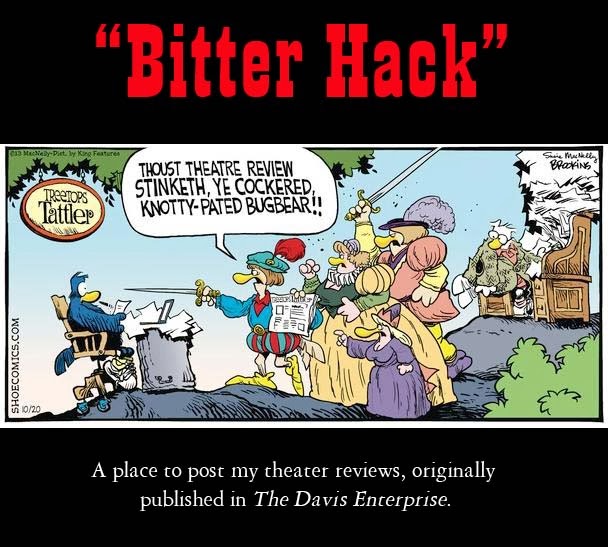Peggy Shannon beamed at me over coffee at Starbucks.
“I feel like I'm the luckiest girl in the world,” she said ... and she meant it.
Shannon, artistic director of the Sacramento Theatre Company for the past 11 years — and a professor in UC Davis' theater and dance department — had reason to be happy. She recently signed a contract to become the chair of the Ryerson Theatre School in Toronto, described as “The Juilliard of Canada.”
Since its founding in 1971, the Ryerson Theatre School has produced hundreds of working actors, dancers, playwrights, choreographers, teachers, educators, directors, lighting and sound technicians, set and costume designers, stage managers and other theater professionals. Alumni work in stage, film, television, festivals, concerts, education, trade and industrial shows, as well as other venues in Canada, the United States and abroad.
Some continue with postgraduate studies or launch their own theater and dance ventures, companies, schools or festivals.
“Up to now, they've been very inwardly focused, to maintain the excellence of the curriculum,” Shannon explained. “Now they want to be externally focused, to build relationships with other theaters. That's exactly what I do, so it's going to be great.”
If Shannon has learned one thing during her time at STC, it's how to build relationships.
“The day after I got here, our then-president said 'By the way ... we didn't tell you, but we really need to design a new building.' ”
Shannon laughed.
“I spent my first few years in a wonderful partnership with California Musical Theatre, trying to raise money, figuring out naming rights and completely renovating the site. From where it began, to where it is today, is a difference of night and day.”
She also learned how to be an artistic director for the Sacramento community.
“It takes awhile to understand the aesthetic of a community: What do they like? This is an intelligent community, a discerning community. Our demographic is young and a little bit older, and they didn't want the really hard-hitting, cutting-edge stuff. They actually did want the classics.
“They like the diversity that I brought.”
Diversity has been the name of the game at STC, during Shannon's directorship: everything from Moliere to Patsy Cline, from “Noises Off” to a traditional “Othello” and a cowboy version of “The Taming of the Shrew.” She introduced audiences to the works of Indian playwright Chitra Banerjee Divakaruni and African-American playwright August Wilson, whose Pulitzer Prize-winning “Pittsburgh Cycle” of 10 plays she hoped to bring to STC over the coming years, starting with last year's highly successful production of “Gem of the Ocean.”
“That legacy will live on,” she said.
Shannon's legacy also includes STC's School of Arts, which offers elementary, middle and high school students after-school and weekend training programs.
“When I first got here, we had lots of little classes and things, but with no guiding philosophy: just a hodge-podge. I spent about four years devising curriculum, and this is our school's eighth year.”
The Young People's Conservatory includes weekly master classes with renowned theater artists, a season of three shows and the opportunity to audition for age-appropriate roles in STC Mainstage productions.
“Kids Write Plays” is an intensive after-school program designed for elementary and middle schools; it incorporates theater games, writing exercises and performance to introduce local students to the world of theater, At the program's conclusion, students perform their works for teachers, family and friends. The program typically lasts at least six weeks.
Coming soon: a 10-month program that'll teach young people about technical theater, and another program that will focus on training for a career in musical theater.
Despite the economic downturn and the overall slow-down in subscribers — not only at STC, but at all theaters in the region — Shannon is proud to report that “fewer people are buying season subscriptions, but more people are buying single tickets. It's a different paradigm nationally.”
Clearly, Shannon is leaving behind a healthy, robust theater company. She will be succeeded by Matt K. Miller, familiar to STC patrons for his many acting and directing roles, not only at STC but at other area theaters.
“I'm really excited that it's Matt. He's so talented. I brought him here, nurtured him; it feels right and good. Our patrons know him; our parents and students know him; our staff knows him. It's a smooth transition.”
“The symmetry is nice,” Miller said. “I started here when Peggy did. I've had the opportunity all these years to be an actor and director. Peggy fostered my playwriting as well, and she helped me become a teacher.” (Miller teaches master classes at the Theater of Arts.)
“It feels natural and logical now, to bring it all to a leadership role. It's a nice succession, as a culmination of our friendship.”
Miller has not been given the job permanently.
“It's de rigueur to do a national search for a job like this,” he explained, “but the board has made it clear to me that my hat is definitely in the ring, and they're willing to consider me for the permanent position.”
As for Shannon, she's in Greece at the moment, leading her UC Davis Summer Abroad program, a four-week “theater retreat” where students study ancient Greek theater, music and dance. This is the 10th year for the program, which originally was offered under the auspices of STC.
After that, Shannon and her daughter will move into a “tiny, tiny apartment” in Toronto, while her husband and son stay in their home in Sacramento.
“It will be an adventure,” she admitted. “It'll be tough, but everybody in my family seems excited and supportive. We all know it's going to be a hardship in some ways.”
Looking back over Shannon's accomplishments during the past 11 years, one certainly believes that the temporary hardship will be worth it: The Ryerson Theatre School will benefit greatly from Shannon's expertise, and from her love of and enthusiasm for her chosen career.



